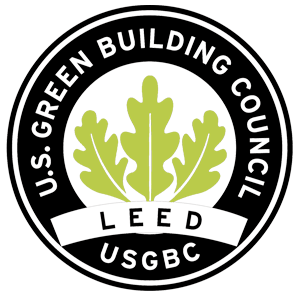
When it comes to America’s waste, buildings have a lot to answer for. 39% of the country’s energy consumption comes from buildings, which are also responsible for 30% of the country’s waste. Inefficient usage of materials, water and energy is bad for the environment. It’s also terrible for budgets.
To combat this waste, the U.S. Green Building Council developed the gold standard in green buildings. The Leadership in Energy and Environmental Design (LEED) certification is a professional credential. LEED verifies that a building is operating using efficient environmental systems, with a concerted effort to preserve energy and water, lower CO2 emissions, and maintain responsible stewardship of resources.
The LEED assessment takes many factors into account: the design process, the location of sustainable sites, indoor environmental quality, the energy and atmosphere and materials and resources.
One other key part of LEED certification is water. There is much to consider, from onsite water reuse to mitigating runoff. If you decrease your building’s water demands, you create an overall more sustainable system. When reaching for a LEED credential, don’t forget about including a framework for smart water use. Here’s everything you need to know.
What Will LEED Certification Do?
On a general level, LEED certification can help your building to promote individual health, protect resources, protect biodiversity and the ecosystem, reverse the damaging effects of climate change, enhance environmental justice and the entire quality of life within a community. Many forward-thinking companies are making sustainability part of their long-term plans. Having a green building is an external declaration of commitment to sustainability.
- On a more granular level, LEED certification:
- Is good PR for your building and your business
- Can help you set up an infrastructure that saves you money
- May qualify you for federal and local government subsidies, tax incentives and special interest rate programs
- Enhances the quality of life of individuals working and/or living on your premises
What Does It Mean To Consider Water Efficiency For LEED Certification?
The number of people who live in “water stressed” cities is growing, based on a population to water ratio. The availability of potable and fresh water is decreasing. Groundwater is being used more frequently and the demand is getting stronger. A traditional irrigation system does not take these facts into account. To consider water efficiency for LEED certification, all of your water systems must have a focus on habitat protection and water use reduction.
The water efficiency category of LEED makes up between 10% and 15% of the overall assessment. Preparing to pass the water efficiency category for LEED means thinking about your site’s water use on a holistic level, with efficiency and reduction being the main objectives.
You Must Meet Three Water-Use Prerequisites To Be Considered for LEED Certification.
Before being evaluated, make sure that your building meets the following three prerequisites
- Outdoor Water Use Reduction – Demonstrate that either your property doesn’t need a permanent irrigation system (beyond a two-year period) or that you reduce the landscape’s water requirement by 30% from the site’s calculated baseline during peak watering month.
- Indoor Water Use Reduction – Reducing aggregate water use from the site’s calculated baseline. This rule includes apparatuses like toilets, faucets, washers and showerheads. Find a table of calculated baselines for fixtures and settings here.
- Building-Level Water Metering – Install water meters that measure monthly and annual potable water use for the building and grounds. Commit to sharing the water usage data for at least a five-year period from when your building is accepted for LEED certification.
You Can Earn 11 Possible Points Total For “Water Efficiency.”
LEED certification depends on achieving a certain number of points in each designated assessment category. Currently, there is a maximum of 11 points for the “Water Efficiency”, or “WE” category. A new construction should keep in mind the following WE categories:
- Outdoor Water Use Reduction (1 possible point)
- Indoor Water Use Reduction (7 possible points)
- Cooling Tower Water Use (2 possible points)
- Water Metering (1 possible point)
LEED Encourages Working With The EPA’s WaterSense Budget Tool. Prepare for the WE assessment by using the WaterSense tool to estimate how much water should be applied to a landscape, based on your local region and climate data. The tool was designed to help landscapers, building managers and irrigation professionals meet sustainability criteria. Find the WaterSense Tool here.
What Other Tools Can Help With Water Efficiency For LEED Certification?
HydroPoint’s WeatherTRAK irrigation controllers and soil moisture sensors can help you immediately reduce water use.
What Can This Water Reduction Look Like?
Salem City, Utah saved close to one million gallons of water over 180 days by installing HydroPoint’s WeatherTRAK Smart Water Management system. By replacing inefficient irrigation controllers, they reduced water use and gained efficiency and visibility into water use data.
What Matters When Assessing Smart Water Systems? Remember two acronyms: CE and SWAT.
CE is “controller efficiency.” LEED defines CE as the percentage reduction in water use based on a weather-based controller or a moisture sensor-based system. The equation for CE is: 1 – (estimated % overall irrigation water saved by controller). WeatherTRAK ET-series controllers have shown, through more than 20 independent multi-year studies, to save around 35%, yielding a CE of 0.65 (1-0.35 = 0.65).
SWAT is Smart Water Application Technology. It is a project that identifies, researches and promotes water use efficiency through irrigation technology. WeatherTRAK ET-series controllers received testing scores of 100% in irrigation accuracy and 0% in allowable excess when applying irrigation.
Click here to find out how HydroPoint smart water management solutions can help achieve LEED certification.

